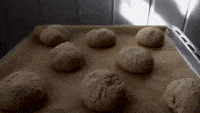By Jenna Beam
If you’ve been on social media lately, you might have noticed that a lot of people are using quarantine to attempt the mother of all breads: sourdough. But why is sourdough so special? And why are people scared to make homemade bread in general?

Let’s start with some bread-making basics. Bread dough is a yeasted dough, meaning that it’s made with – yep, you guessed it – yeast. The most simple bread recipe only has 4 ingredients: flour, water, salt, and yeast. Yeasts are unicellular eukaryotic microorganisms, which is a fancy way of saying they are small organisms that are only made of one tiny single cell. Eukaryotic means that the cell contains a nucleus, mitochondria, and other organelles, just like the cells that make you (but not like bacteria, which are called prokaryotic organisms).
In baking, the yeast is called Saccharomyces cerevisiae. A mouthful, I know, which is why most people just call it baker’s yeast or simply, yeast. There’s also brewer’s yeast, which is used to make beer and other forms of yeast not involved in any sort of food/drink making at all (fulfill all your yeasty learning desires here). When you make bread, you mix all the ingredients together, cover the dough and leave it somewhere nice and cozy to rise. The rising you see is actually the result of a chemical reaction that occurs when the yeast starts to break down the starches and sugars in the flour. We call this process fermentation. When the yeast break down the flour, they produce lactic acid and carbon dioxide – yep, the same stuff you exhale when you breathe. Since carbon dioxide is a gas, it makes the bread puff up (you know, like when you have gas and your stomach puffs up! It’s kind of the same thing, but maybe not quite as yummy).

GIF created on Giphy from https://www.youtube.com/watch?v=89SJhsgjazM.
So what’s so special about sourdough? If you’ve had sourdough bread, or if you can figure it out from the name, sourdough bread is made with a dough that’s…wait for it…sour. The cleverness and wit of our ancestors strikes again! The oldest sourdough recipe dates back to 3500 BCE, although historians think the origins of the sourdough fermentation process date back much further than that. Making sourdough bread requires a sourdough starter. The starter is a mixture of water and flour that you let ferment in a warm spot until it starts producing that trusty carbon dioxide. What’s cool about the starter is that it uses the naturally occurring microorganisms found in the flour, water, and air instead of a packet of baker’s yeast. Like baker’s yeast, these naturally occurring organisms also produce acids as they ferment the starches in the flour, which is what gives the dough that sour taste. Unlike baker’s yeast, which can be stored in it’s packet in the fridge for a very long time, the sourdough starter has to be fed roughly every day to keep it alive, kind of like a pet (although admittedly less cuddly and cute). Most regular bread recipes take a few hours to complete: mix the dough, knead the dough, let it rise TWO SEPARATE TIMES, and then you can bake it – whew! Sourdough bread, however, can take anywhere from six to SIXTEEN HOURS or even longer! Because you’re relying on your starter to make the bread rise, sometimes the first rise ALONE can take 12 hours or more! Now you see why people waited for a national shutdown to attempt it.
Join the social media trend and try making your own bread at home. Or start with experiments like these to see what kinds of things yeast like to eat!
Edited by Emma Goldberg and Rachel Cherney
